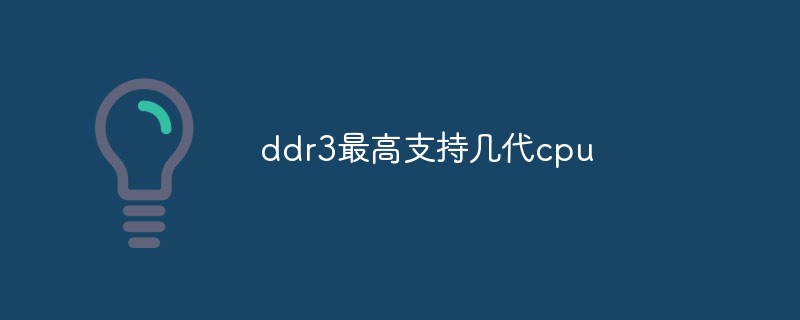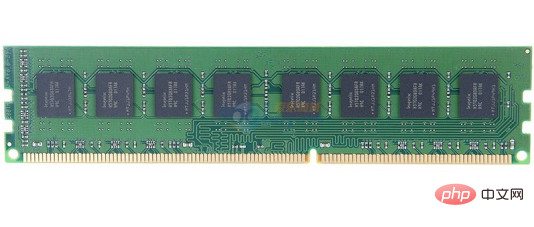
ddr3 supports up to the fourth generation CPU. DDR3 is a computer memory specification. The third generation of DDR3 memory can only support up to the fourth generation Core series processors. DDR3 is a memory product belonging to the SDRAM family, providing higher operating performance and lower voltage than DDR2SDRAM. The performance advantages of ddr3: 1. Lower power consumption and heat generation; 2. Higher operating frequency; 3. Reduce the overall cost of the graphics card; 4. Good versatility.

The operating environment of this tutorial: Windows 7 system, Dell G3 computer.
ddr3 supports up to the fourth generation CPU.
DDR3 is a computer memory specification. The third generation of DDR3 memory can only support up to the fourth generation Core series processors, which is the fourth generation CPU. DDR3 is a memory product belonging to the SDRAM family. It provides higher operating performance and lower voltage than DDR2SDRAM. It is the successor of DDR2SDRAM (synchronous dynamic random access memory) (increased to eight times) and is also currently popular. Memory product specifications.

Comparison between ddr3 and DDR2
1. Burst Length (BL):
Due to The prefetch of DDR3 is 8bit, so the burst transmission period (Burst Length, BL) is also fixed at 8. For DDR2 and early DDR architecture systems, BL=4 is also commonly used. DDR3 adds a 4bitBurst Chop (Burst Chop) for this purpose. mutation) mode, that is, a BL=4 read operation plus a BL=4 write operation are combined into a BL=8 data burst transmission. This burst mode can be controlled through the A12 address line. . And it should be pointed out that any burst interrupt operation will be prohibited and not supported in DDR3 memory, and will be replaced by more flexible burst transmission control (such as 4bit sequential burst).
2. Addressing timing (Timing):
Just like the number of delay cycles increases after DDR2 changes from DDR, the CL cycle of DDR3 will also be improved compared to DDR2. The CL range of DDR2 is generally between 2 and 5, while that of DDR3 is between 5 and 11, and the design of the additional delay (AL) has also changed. The range of AL in DDR2 is 0~4, while in DDR3 AL has three options, namely 0, CL-1 and CL-2. In addition, DDR3 also adds a new timing parameter - write delay (CWD), which will be determined based on the specific operating frequency.
3. DDR3’s new reset (Reset) function:
Reset is an important new function of DDR3, and a pin is specially prepared for this. The DRAM industry has long requested the addition of this feature, and now it has finally been implemented on DDR3. This pin will make the initialization process of DDR3 easy. When the Reset command is valid, DDR3 memory will stop all operations and switch to a minimum amount of activity to save power. During the Reset period, DDR3 memory will turn off most of its internal functions, all data receivers and transmitters will be turned off, all internal program devices will be reset, DLL (delay locked loop) and clock circuits will stop working and ignore Any movement on the data bus. In this way, DDR3 will achieve the most power-saving purpose.
4. DDR3 adds ZQ calibration function:
ZQ is also a new pin, and a 240 ohm low-tolerance reference resistor is connected to this pin. This pin uses a command set to automatically verify the data output driver on-resistance and ODT termination resistance value through the on-die calibration engine (ODCE). When the system issues this instruction, it will use the corresponding clock cycles (512 clock cycles after power-on and initialization, 256 clock cycles after exiting the self-refresh operation, and 64 clock cycles in other cases). On-resistance and ODT resistance are recalibrated.
5. The reference voltage is divided into two:
In the DDR3 system, the reference voltage signal VREF, which is very important for the operation of the memory system, will be divided into two signals, which serve the command and address signals. VREFCA and VREFDQ serving the data bus, which will effectively improve the signal-to-noise level of the system data bus.
6. Point-to-Point (P2P):
This is an important change made to improve system performance and is also a key difference between DDR3 and DDR2.
In the DDR3 system, a memory controller only deals with one memory channel, and this memory channel can only have one slot. Therefore, the memory controller and the DDR3 memory module are point-to-point (P2P). relationship (single physical Bank module), or point-to-two-Point (P22P) relationship (double physical Bank module), thus greatly reducing the address/command/control and Data bus load.
In terms of memory modules, similar to the categories of DDR2, there are also standard DIMM (desktop PC), SO-DIMM/Micro-DIMM (notebook computer), and FB-DIMM2 (server), among which The second generation of FB-DIMM will use AMB2 (Advanced Memory Buffer) with higher specifications.
DDR3 for 64-bit architecture obviously has more advantages in frequency and speed. In addition, due to other functions such as automatic self-refresh and partial self-refresh based on temperature, DDR3 is also excellent in terms of power consumption. Much more, so it's likely to be popular first in mobile devices, just as DDR2 memory was first embraced not in desktops but in servers.
In the field of PC desktops where CPU FSBs are improving the fastest, the future of DDR3 is also bright. The new chip launched by Intel, Bear Lake, will support the DDR3 specification, and AMD is also expected to support both DDR2 and DDR3 specifications on the K9 platform.
ddr3 performance advantages
(1) Small power consumption and heat generation: lessons learned from DDR2 have been learned, and energy consumption and heat generation have been reduced while controlling costs. Heat generation makes DDR3 more acceptable to users and manufacturers.
(2) Higher operating frequency: Due to reduced energy consumption, DDR3 can achieve higher operating frequency, which to a certain extent makes up for the shortcomings of long delay time. It can also be used as one of the selling points of the graphics card. This has already been demonstrated on graphics cards equipped with DDR3 video memory.
(3) Reduce the overall cost of the graphics card: The specifications of DDR2 video memory particles are mostly 16M The specifications of DDR3 video memory particles are mostly 32M In this way, the PCB area of the graphics card can be reduced and the cost can be effectively controlled. In addition, after the number of particles is reduced, the power consumption of the graphics memory can be further reduced.
(4) Good versatility: Compared with the change from DDR to DDR2, DDR3 has better compatibility with DDR2. Since key features such as pins and packaging remain unchanged, graphics cards equipped with DDR2 graphics cores and public version designs can use DDR3 graphics memory with slight modifications, which is of great benefit to manufacturers in reducing costs.
DDR3 graphics are widely used in most new mid-to-high-end graphics cards. Many low-end graphics cards also use DDR3 video memory.
Extended knowledge: fourth-generation cpu
The fourth-generation processor, the fourth-generation Core processor, was officially launched on June 2, 2013.
Can be applied to motherboards, systems, laptops and even tablets.
For more related knowledge, please visit the FAQ column!
The above is the detailed content of DDR3 supports up to several generations of CPUs. For more information, please follow other related articles on the PHP Chinese website!
 What to do if the CPU temperature is too high
What to do if the CPU temperature is too high
 A memory that can exchange information directly with the CPU is a
A memory that can exchange information directly with the CPU is a
 The main components that make up the CPU
The main components that make up the CPU
 What are the video server configuration parameters?
What are the video server configuration parameters?
 How to solve cpu fan error
How to solve cpu fan error
 What to do if the CPU usage is too high
What to do if the CPU usage is too high
 Introduction to CPU performance index parameters
Introduction to CPU performance index parameters
 python configure environment variables
python configure environment variables